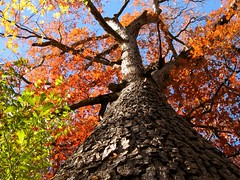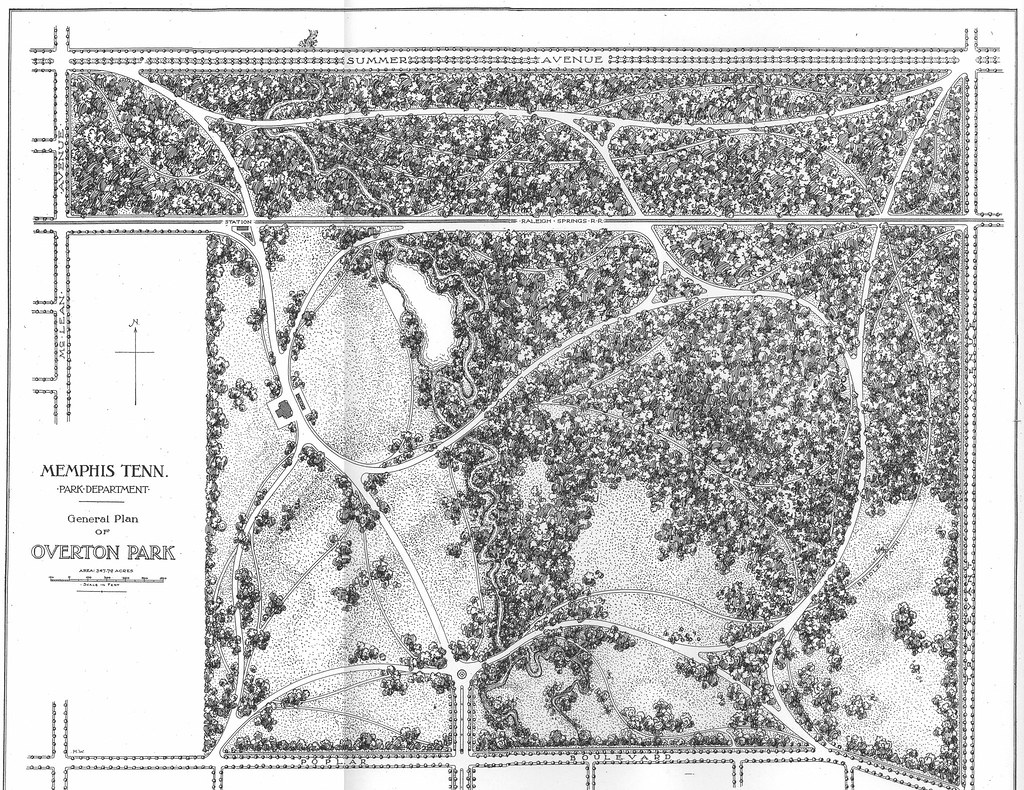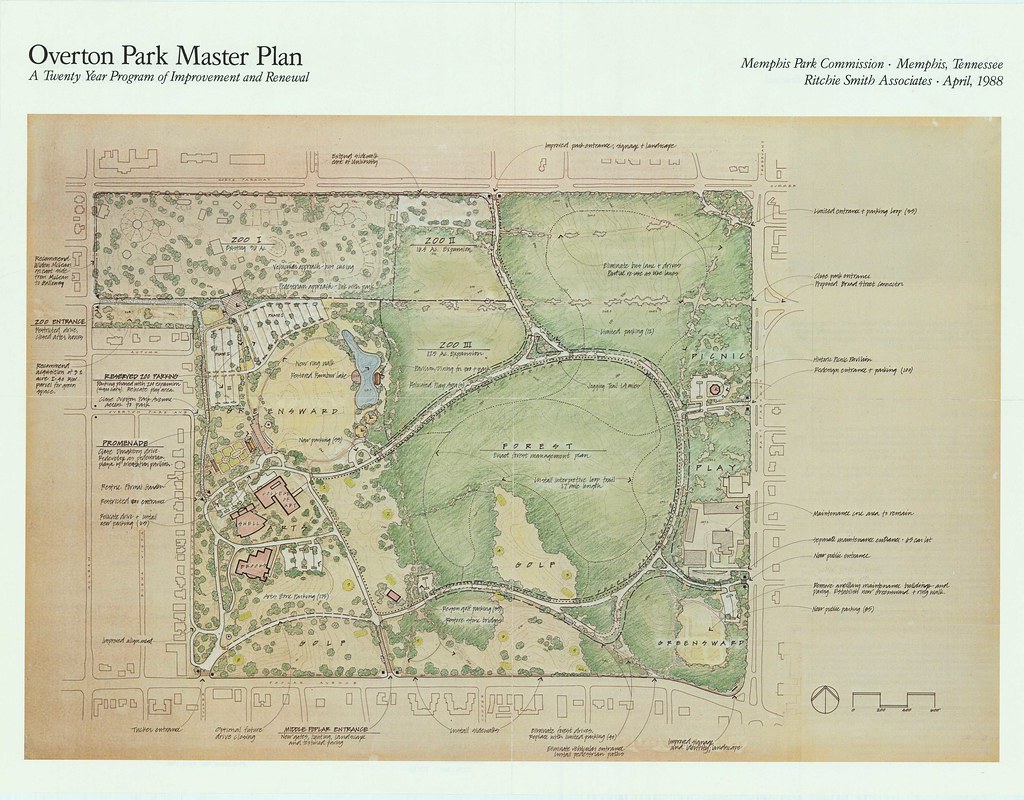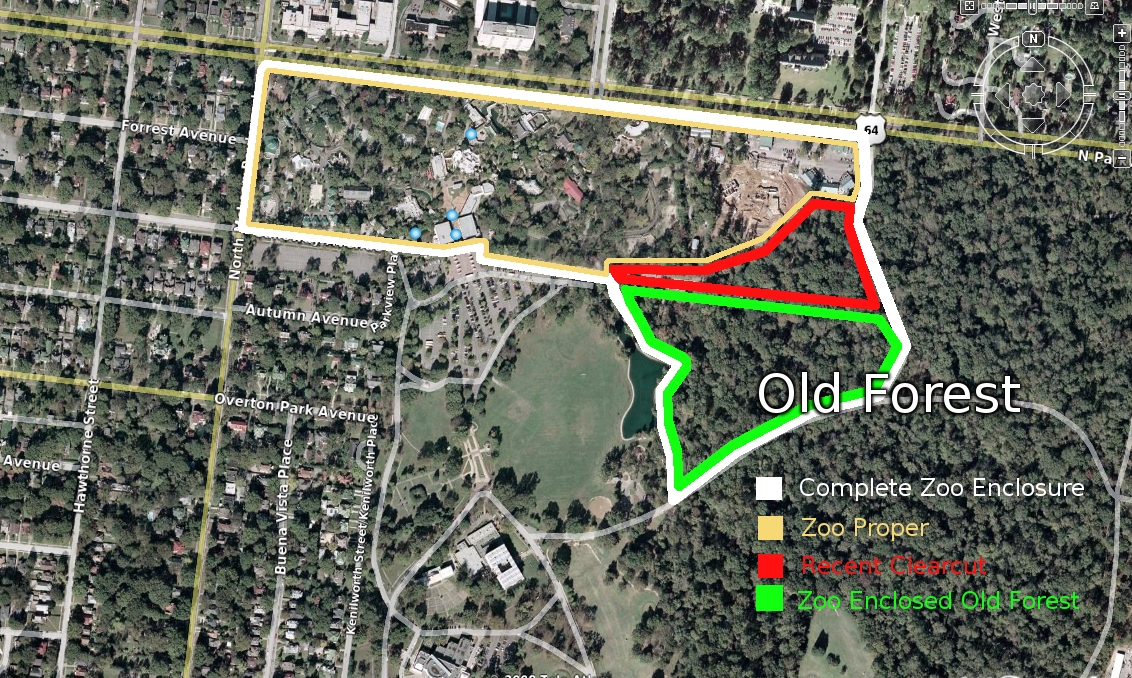On November 28, 1978, Overton Park was nominated for the National Register of Historic Places. That nomination was approved by the U.S. Department of the Interior in 1979.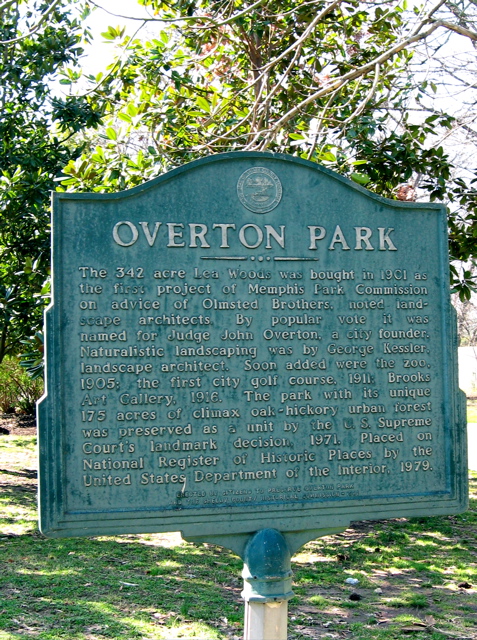
The nomination form was prepared by James F. Williamson Jr., a local architect. A bound photocopy is available in the Memphis Room of the Central Library if you wanna take a gander for yourself.
I made copies of the text but not the photos, because photocopies of photocopied photos are just a waste of good toner. To begin with, I've transcribed the inventory of existing structures. The numbers refer to this site plan:
As always, click to enlarge the image. The resolution on those teeny numbers is crappy but should be readable if you download the image. Make sure you limber up your squint muscles first to prevent injury. If you really want the 3.5MB version just email me.
- Main Entrance Gateposts: 1954, classical style, stone with balustrades, bronze plaques and carved eagles.
- E.H. Crump Memorial: 1957, bronze statue with stone base.
- Gazebo: Concrete with wood lattice pergola and drinking fountain.
- Brooks Memorial Art Gallery: 1916, white Georgia marble, Italian Renaissance Revival style; two later additions (1944 and 1973), landscaped gardens, monumental exterior stairs and terraces.
- Memphis Open Air Theatre: 1936, reinforced concrete orchestra shell, wooden benches and stage; modern metal storage wings.
- Memphis Academy of Arts: 1956, reinforced concrete and buff-colored brick, 3 stories; folded plate concrete roof.
- L.B. McFarland Memorial Campanile: c. 1906, twenty-five foot granite tower with clock and chimes.
- Clara Conway Memorial Formal Gardens: c. 1908, concrete walkways.
- Jenny M. Higbee Memorial: 1908, six marble Ionic columns on a semi-circular marble base surrounding a drinking fountain.
- "Doughboy" World War I Memorial: 1926, bronze statue of soldier on stone base.
- Wading Pool: 1914, concrete with water spray in center.
- Abe Goodman Golf Clubhouse: 1926, brick, Tudor-style, 1 1/2 story, tile roof, brick patio.
- Rainbow Lake: c. 1910, two-acre man-made lake.
- Bus Pavilions: c. 1910-1920, open wood frame, hipped roofs, wooden benches.
- Zoo Entrance Gate Posts: 1935, masonry, 10 feet in height, with carved stone lions.
- [Item missing.]
- Carnivora Building: 1909, one story, stuccoed masonry, clerestory, indoor and outdoor cages; decorative animal sculptures on exterior, including four lions with children.
- Old Pachyderm House (Education Building): 1909, one story, stuccoed masonry.
- Primate House: Modern, reinforced concrete, one-story with skylights and outdoor wire mesh cages.
- Flight Cage: 1935, 40 feet high, cylindrical steel frame with wire mesh enclosure.
- Bear Caves: c. 1939, concrete cliffs, moats, and dens.
- Otter Cave: c. 1939, concrete caves and pool, earth berm at rear, underground viewing chamber.
- Wolf Caves: 1939, concrete caves and moats.
- Monkey Island: 1936, concrete moat and retaining walls, earth mound with stone caves.
- East Concession: Modern, stone and wood frame, flat roof.
- Hooved Animal Corrals: Concrete retaining walls and open shelters with flat roofs.
- Maintenance Shop: Modern, concrete block with pitched shingled roof.
- Animal Hospital: Modern, one-story, brick, with flat built-up roof.
- Commissary: Modern, one-story, painted brick and concrete block, flat roof.
- North Restrooms: Modern, one-story brick, flat built-up roof.
- Hippopotamus House: Modern one-story, brick, flat built-up roof, with open gallery and concrete moats.
- Tortoise House: Modern, one-story, brick, with open gallery and concrete walled courtyards.
- Reptile House: Modern, reinforced concrete, one-story, covered with earth berm.
- Office Building: Modern, one-story, masonry, with flat roof.
- Sea Lion/Swan Pools: c. 1936, stone and concrete pools and walls; circular; divided into two pools.
- Ibex Mountain: c. 1939, concrete cliffs and dens; modern reinforced concrete moat and retaining walls.
- Octagon Barn: Stone, octagonal plan with octagonal roof and cupola; concrete walled courtyards.
- West Concession/Restrooms: Modern, one-story, concrete, with flat roof.
- Superintendent's House: c. 1910, one-story cottage, marble and wood frame exterior.
- Aquarium: Modern, one-story, brick, with flat roof; brick garden walls.
- Tropical Bird House: Formerly the "Palm House," extensively remodeled with translucent plastic and corrugated metal roof panels, brick walls.
- Amusement Area: Merry-go-round, other mechanical rides for small children.
- New Pachyderm House: Modern, one-story, reinforced concrete, flat roof, concrete and heavy timber retaining walls and moats.
- Hooved Animal Corrals: Modern, with concrete dens, and earth berm enclosures, concrete retaining walls.
- East Gate/Restrooms: Modern, reinforced concrete, one-story, with flat roof.
- Picnic Pavilion: Wood frame, with wood floor, open side railings, roof lantern, hexagonal plan.
- Fire Station No. 13: Modern, masonry, with composition shingle mansard roof and walls.
- Park Commission Office Building: Modern, one-story, wood and stone, with flat built-up roof.
- Maintenance Shop Building: c. 1935, one-story, poured concrete, with flat roof.
- Storage Building: Modern, prefabricated metal construction, one-story.
- Utility Building: Concrete masonry, one-story, pitched roof.
- Garage: Modern, one-story, prefabricated metal construction.
- Utility Building: Modern, one-story, prefabricated metal construction.
- Private Residence (215 E. Parkway): c. 1920, 1 1/2 story, wood frame cottage with front porch, masonry foundation walls and chimneys. [Handwritten note: "Removed 1980."]
- Greenhouses: Modern, six glass and steel frame greenhouse wings with concrete block structure in center.
- Utility Building: Modern, one-story, concrete block and wood frame, flat roof.
- Parking Shed: Modern, prefabricated metal, open sides.
Hope all you history buffs enjoyed this little trip down Monkey Island Lane. I'll transcribe the nine pages of descriptive text about Overton Park and post that soon -- it's good reading, and information wants to be free.
